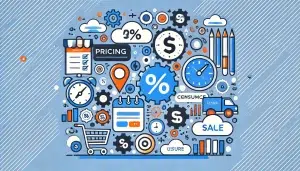Holidays are pivotal in ecommerce and present immense opportunities and formidable challenges. Implement effective pricing strategies to outmaneuver competitors and captivate price-conscious consumers with these tips.
A good video from Shopify to start with the concept of Pricing Strategies
Navigating Inflation
Inflation is a significant concern for businesses and consumers alike. As prices rise, consumers become more cautious about their spending habits, seeking out discounts and promotions to mitigate the impact on their budgets. This shift in consumer behavior creates a challenge for businesses to navigate. Adapting to this “inflationary psychology” requires a proactive approach to pricing strategies.
For businesses, the ability to adjust pricing swiftly and strategically is essential to remain competitive in a market marked by inflation. This may involve reevaluating product pricing, offering targeted promotions, or exploring innovative pricing models to appeal to price-conscious customers. Additionally, businesses need to closely monitor market trends and consumer sentiment to anticipate and respond to changing purchasing behaviors.
Effective communication with customers about pricing changes and value propositions becomes crucial during times of inflation. Providing transparency and clarity about pricing adjustments can help build trust and maintain customer loyalty. Businesses that can effectively navigate these challenges and adapt their pricing strategies to align with consumer expectations will be better positioned to thrive in an inflationary environment.
A New Era of Consumer Expectations
The pandemic has catalyzed a seismic shift in consumer expectations and shopping habits. Online shopping has skyrocketed, with an unprecedented number of first-time online shoppers and new competitors entering the fray.
A 2023 study showed that 42% of consumers plan on purchasing online, and most of those shoppers want to consolidate their shopping to a limited number of retailers rather than shopping around.
The digital transition has brought about a seismic shift in the retail industry, requiring brands to rethink their approach to engaging with consumers. Traditional tactics no longer guarantee success in a landscape where digital experiences and online shopping have become the norm. To truly thrive in this new environment, retailers must embrace a holistic strategy that encompasses a deep understanding of evolving shopper expectations, the impact of inflation, and the changes in consumer behavior following the COVID-19 pandemic.
Developing a deep understanding of evolving shopper expectations is crucial for retailers looking to establish a meaningful connection with their target audience. This involves not only analyzing purchasing patterns and preferences but also recognizing the growing significance of factors such as sustainability, convenience, and personalized experiences in shaping consumer decisions.
Innovation and the implementation of fresh pricing strategies are key to adapting to these transformative changes. This may involve leveraging technology to enhance the online shopping experience, exploring new ways to engage with consumers through social media and influencer partnerships, and reimagining the physical retail space to offer an immersive and interactive environment.
Research indicates that 79% of holiday shoppers plan to commence their gift-hunting earlier than ever before and 51% of those are driven by the desire to capitalize on discounts and deals. This presents a golden opportunity for savvy retailers to capture the attention of these early birds by offering enticing promotions and competitive pricing from the outset.
Personalized Discounts: The Key to Unlocking Customer Loyalty
Once, sending out generic discount emails en-mass held some value to customers. Today, it is seen as unpersonalized in an era where consumers crave that personal touch. To truly resonate with your customers, you must leverage customer data to craft tailored discounts and price drop notifications. By analyzing browsing behavior, wish lists, and abandoned carts, you can deliver targeted promotions that speak directly to individual preferences and interests.
The Art of Bundling: Boosting Impulse Purchases
While inflation might be at the forefront for many shoppers, strategically bundling products can inspire those impulsive purchases that boost sales and profits. By offering custom bundles with enticing discounts, you empower your customers to curate their own unique packages, enhancing perceived value and driving sales without compromising profit margins.
Additionally, it makes your customer feel heard as you have created bundles that resonate with their purchasing needs so they don’t need to shop around at too many ecommerce stores.
Optimizing Site Performance: A Prerequisite for Holiday Success
As the holiday rush approaches, ensuring a seamless online shopping experience becomes paramount. Site speed and stability should be top priorities, as even minor hiccups can drive customers away. Retailers must proactively address performance bottlenecks, ensuring their websites can handle the influx of traffic without compromising load times or uptime.
Consumers also expect to seamlessly navigate between online and offline channels in a consistent and cohesive shopping experience across all touchpoints. To meet these expectations, you must integrate your pricing strategies across various platforms, ensuring uniformity and transparency in pricing, promotions, and product availability.
Dynamic Pricing Strategies: Staying Ahead of the Competition
In this ever-evolving retail landscape, static pricing strategies are no longer sufficient, you need to be able to alter your pricing in an instant. To maintain a competitive edge, you must adopt dynamic pricing methodologies that enable real-time adjustments based on market conditions, competitor pricing, and inventory levels. By leveraging advanced pricing software and data analytics, you can respond swiftly to fluctuations, maximizing profitability while offering compelling value to customers.
Loss Leader Tactics: Driving Traffic and Boosting Sales
One potent pricing tactic for the holiday season is the strategic use of loss leaders – products sold at a loss to generate foot traffic and expose shoppers to additional offerings. You can view it like a garage sale, where you have some items sold at a real bargain, in the hope that as they browse, they’ll come across some of your gold ticket items.
By identifying popular, high-demand items and offering them at unbeatable prices, you can attract a deluge of comparison shoppers from various platforms, including search engines and price comparison websites.
Quite simply, if you’re selling a similar product to your competitor and offer a crazy price deal, they will purchase from you – as long as your online presence is seamless.
Upselling and Cross-Selling: Boosting Average Order Value
Upselling and cross-selling are powerful techniques for increasing average order value (AOV) up to 20% with minimal marketing effort. By presenting customers with complementary products, premium upgrades, or value-added bundles, retailers can inspire additional purchases and maximize revenue from each transaction.
The best online retailers utilize this strategy through showing what other customers bought together with the same product or similar products that would compliment it.
Lets face it, e-commerce is a cutthroat retail arena in today’s market and the more comprehensive understanding you have of your competitors pricing strategies will definitely serve your business well. By employing competitive intelligence tools and monitoring rivals’ pricing, stock levels, and promotional activities, you can proactively adjust your tactics swiftly.
Inventory Management: Ensuring Seamless Fulfillment
No customer likes to order a product to receive a message that the product is out of stock or no longer available. There is psychological joy when customers feel they have made the purchase. There is also deep disapproval when that is taken away from them. There is no faster way to lose a customer (and potentially many more throughout word of mouth) than not having an effective inventory management system. It is a critical component of a successful holiday pricing strategy.
By closely monitoring stock levels and implementing dynamic pricing based on availability, you can optimize profit margins during periods of high demand while avoiding out of stock products that could alienate customers and lead to lost sales.
Leveraging Social Media: Amplifying Promotions and Driving Engagement
Social media platforms have emerged as powerful marketing channels, enabling retailers to amplify their promotions, engage with customers, and build brand loyalty.
Through carefully tailored and compelling social media campaigns, leveraging influencer partnerships, and collaborations, you can strengthen your brand and foster a sense of community with your followers.
The more visibility you gain in this manner and the more traffic you recieve, it will ultimately boost sales during the holiday season.
Embracing Agility in Holiday Promotions in 2024
As the 2024 holiday season approaches, retailers must embrace agility and data-driven decision-making to thrive. By continuously monitoring consumer behavior, market trends, and competitor activities, you can adjust your pricing strategies in real-time, capitalizing on opportunities and making sure you don’t miss sales because your competition is offering incredible prices that you are unaware of.
Successful holiday pricing requires a delicate balance of competitive pricing, strategic promotions, and a deep understanding of consumer psychology. By implementing the tactics outlined, you can position yourself for a triumphant 2024 holiday season, maximizing profitability while delivering exceptional value to your customers.
Here some links you could find interesting about Pricing Strategies topic:
- Pricing Strategies
- The Ultimate Guide to Pricing Strategies & Models
- Competitive Pricing: Definition, Examples, and Loss Leaders
- Ecommerce Pricing Strategies: How to Scale and Grow Without Losing Profit
- Ecommerce Pricing Strategies to Boost Sales and Conversion Rates
- Understanding Pricing Strategies, Price Points And Maximizing Revenue




